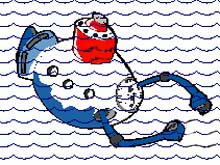
This expedition education module focuses on the Okeanos Explorer: A New Paradigm for Exploration.
Educational Resources for Teachers
Technology enables each advancement made in exploration, from the poles to the deepest reaches of the ocean, to the moon and beyond. Discovery of new life forms at hydrothermal vents was made possible by submersible vehicle technology, and continued enhancements in satellite sensor technologies provide ever-improving discoveries of planetary scale changes like those due to El Niño and those talking place in the deepest parts of the ocean. It is cutting-edge technology that enables us to expand the boundaries of the known world and those of our own minds while engaging all who wish to be involved in these discoveries in real-time. At the same time, these ever-emerging technological capabilities provide compelling incentives for students to get close-up looks at scientific, technical, engineering, and mathematics ocean-related careers. With the unprecedented advancements in all areas of technology, learning is no longer restricted to a place and time, and students are perhaps the most profoundly affected by this evolution in how they learn and where they learn than any other segment of our society.
The availability of visualizations and real-time data and other scientific information through the Internet greatly enhances ocean sciences content in classrooms in innovative and engaging ways. The world has sophisticated technological capabilities that have made the ocean more “visible” and more accessible than ever before. Satellite imagery with easy to use viewing software, computer-generated model output and visualizations, interactive maps, and real-time video technologies provide additional enhancements to teaching ocean science to anyone…and provide anyone with the opportunity to explore the ocean.
The NOAA Ship Okeanos Explorer, outfitted with state-of-the-art telepresence capabilities, will enable us to expand the reach of NOAA ocean science in novel ways in formal and informal teaching and learning environments. We will bring real-time visualizations and data from the ocean floor to the classroom through satellite technologies and the Internet, enhancing ocean science content on the Ocean Explorer Web site in innovative and engaging ways that are in direct alignment with the National Science Education Standards (NRC, 1996) and the Ocean Literacy Essential Principals and Fundamental Concepts.
As the NOAA Ship Okeanos Explorer becomes operational, guidance for NOAA’s Ocean Exploration Education Program with it new telepresence component will continue to come from the ocean science education community and the science community at large through a series of workshops to be organized this fall. These workshops will focus on finding a common ground for what telepresence on board the NOAA Ship Okeanos Explorer is capable of bringing to formal and informal learning environments and what the users want to achieve with access to ocean science content through telepresence. A few of issues to be addressed in these workshops might include:
- Balancing a familiar teaching environment while adapting to state-of-the-art telepresence capabilities in the classroom;
- Development of teaching activities/modules and associated professional development;
- Development of the teaching and learning environment;
- Testing of prototype learning environments;
- Classroom-based coaching to enable teachers to enact new knowledge and new skills; and
- Evaluation.
The following links will take you to NOAA ocean exploration expeditions have been conducted in recent years as “proofs of concepts” for using telepresence to conduct exploration. In these expeditions, you will find educational materials that have been developed for teachers of students in Grades 5-12.
- The Lost City - http://oceanexplorer.noaa.gov/explorations/05lostcity/welcome.html
- Titanic - http://oceanexplorer.noaa.gov/explorations/04titanic/welcome.html
- Aegean and Black Sea - http://oceanexplorer.noaa.gov/explorations/06blacksea/welcome.html
The following links will take you to expeditions have been conducted in recent years in the region where the current expedition is taking place. In these expeditions, you will find educational materials that have been developed for teachers of students in Grades 5-12.
- Project PHAEDRA 2006 - http://oceanexplorer.noaa.gov/explorations/06greece/welcome.html
- Aegean and Black Sea - http://oceanexplorer.noaa.gov/explorations/06blacksea/welcome.html





